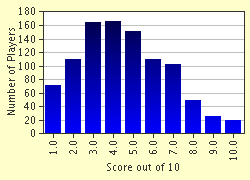Quiz Answer Key and Fun Facts
1. The world's original landmass, from which today's continents and other major landmasses emerged, was called Pangaea. What, however, was the name of the world's first ocean?
2. Which mountain range extends for more than 100 miles into England from the Scottish border?
3. The Effigy Mounds National Monument is home to prehistoric indian sculptures. The Indians molded mounds into the shape of animals. Where is this monument located?
4. The Running of the Bulls occurs every year in the city of Pamplona in Spain as a part of the Los Sanfermines, a festival. In what Spanish region, however, is the city of Pamplona?
5. The highest navigable lake in the world is Lake Titicaca. Between which two countries does it lie?
6. Oil is transported out of the Persian Gulf along what strait?
7. Romania is a small European country surrounded by five other nations. Four of these countries include Serbia, Ukraine, Hungary and Bulgaria. What is the missing fifth country?
8. The oldest hereditary monarchy in the world resides in Japan. What is the symbol for the Japanese monarchy?
9. Every year outside of Riyadh the Jenadriyah Camel Race occurs, an effort to preserve a part of what country's heritage?
10. The Russian space-launch facility, the Baikonur Cosmodrome is situated by the Aral Sea. What country is it in?
Source: Author
TemplarLLM
This quiz was reviewed by FunTrivia editor
spanishliz before going online.
Any errors found in FunTrivia content are routinely corrected through our feedback system.


